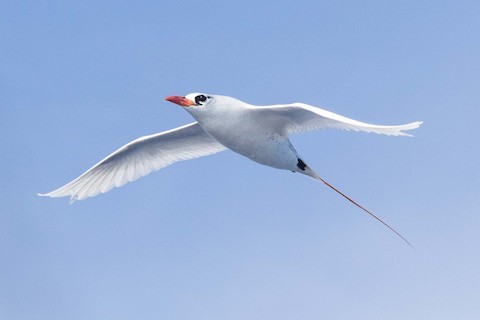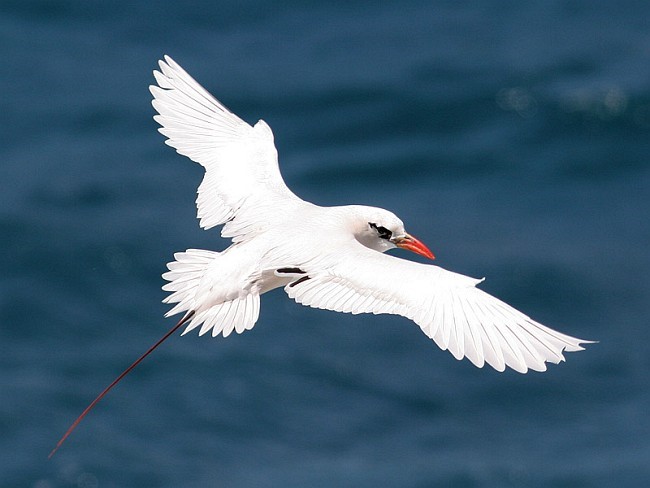Birdfinding.info ⇒ Fairly common over large but remote portions of the Indian and Pacific Oceans. The most accessible breeding colony is at Lana’i Lookout in Koko Head Regional Park, a few miles east of Honolulu, where it is present from February to October. The other accessible Hawaiian site where it is readily observed during those months is Kilauea Point National Wildlife Refuge on Kauai. On the Big Island, it has been found at Upolu Airport and Pololu. Other accessible breeding sites include Christmas Island, Lady Elliot Island (offshore from Gladstone, Queensland), Norfolk Island, Easter Island (Chile), and Nosy Ve (Madagascar). Occasionally seen on pelagic trips off of eastern Australia and central and southern California.
Red-tailed Tropicbird
Phaethon rubricauda
Tropical and subtropical offshore islands and waters of the Indian and Pacific Oceans.
Breeding. In the western Indian Ocean, nests on islets southwest of Madagascar, the Comoros, the Seychelles, Mauritius, and Réunion. In the east, on the Cocos (Keeling) Islands, Christmas Island, and eastward on islets in the Timor, Banda, and Arafura Seas.
Widespread across the tropical Pacific: in the north from Nansei Shoto and the Ogasawara Islands to Hawaii; and in the south from islets in the Coral and Tasman Seas south to Lord Howe and Norfolk Islands, east through New Caledonia, Fiji, Tonga, the Cook Islands, and essentially throughout Polynesia to Easter Island.
In Hawaii, present from February to October, nesting on all islands of the Northwest Chain (about 12,800 pairs, with 7,500 on Midway), and locally in the main islands (about 1,000 pairs), including concentrations at Kaula Rock, Lehua Islet, northern Kauai (Kilauea Point), and southeastern Oahu (Koko Head and several islets), and lower numbers around northern and eastern Molokai, Lanai, Kaho’olawe, and the north end of the Big Island.

Red-tailed Tropicbird on a nest at Midway Atoll, Hawaii—one of its largest nesting colonies. (June 22, 2008.) © Robert Webster
Nonbreeding. Exclusively pelagic away from its breeding grounds, usually far from continental coasts. Wanders widely across the Indian and Pacific Oceans, including some temperate areas—e.g., it is believed to occur regularly far offshore north at least to central California, and possibly north to British Columbia waters.
Identification
Unmistakable if seen well: the whitest tropicbird, unique in having two long thin wire-like red tail feathers.
Adult has nearly all-white plumage with mostly coral-red bill, its eponymous red streamers, black “teardrop” mark, short black eyeline, and black webbed feet, which it often extends.
Although the adult is nearly all-white, its outer primaries sometimes show narrow black lines along the shafts. The innermost secondaries often have broader black markings, but these are usually concealed.
Sometimes has a general pinkish flush, especially early in the breeding season.
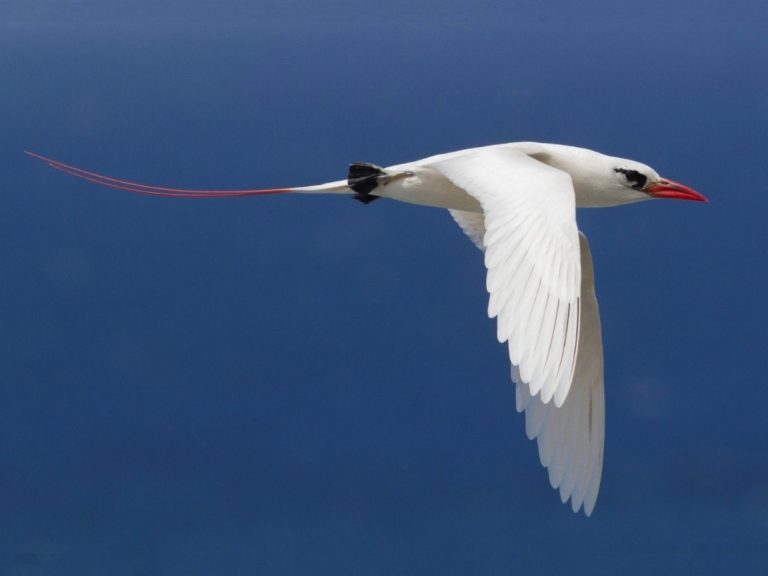
Red-tailed Tropicbird, showing minimal blackish shafts on primaries. (Kilauea Point National Wildlife Refuge, Kauai, Hawaii; May 3, 2016.) © Jacob Drucker

Red-tailed Tropicbird. (Rano Raraku, Easter Island, Chile; June 11, 2009.) © Pablo Andrés Cáceres Contreras
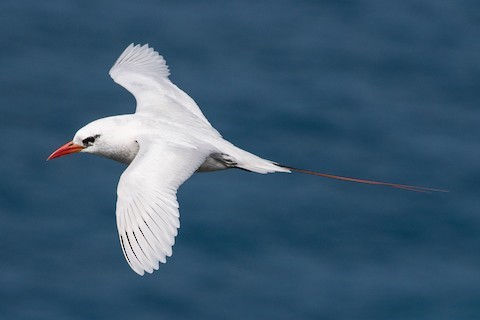
Red-tailed Tropicbird, showing minimal blackish shafts on primaries. (Kilauea Point National Wildlife Refuge, Kauai, Hawaii; May 14, 2020.) © Eric VanderWerf
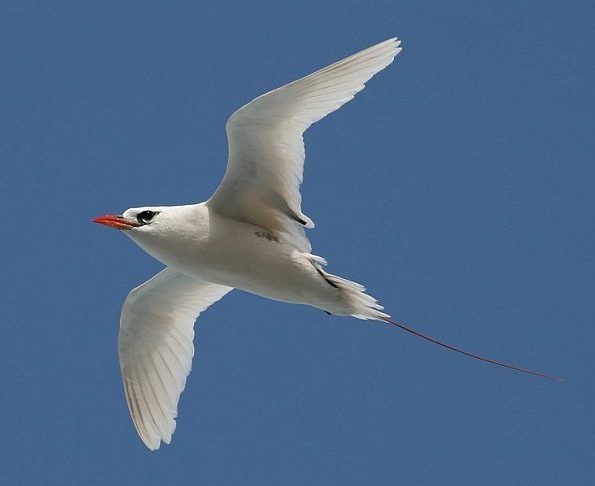
Red-tailed Tropicbird. (Christmas Island; September 3, 2007.) © Cherry Wong

Red-tailed Tropicbird, with a slight pinkish flush that is often seen early in the breeding season. (Kilauea Point National Wildlife Refuge, Kauai, Hawaii; March 24, 2018.) © Russ Morgan
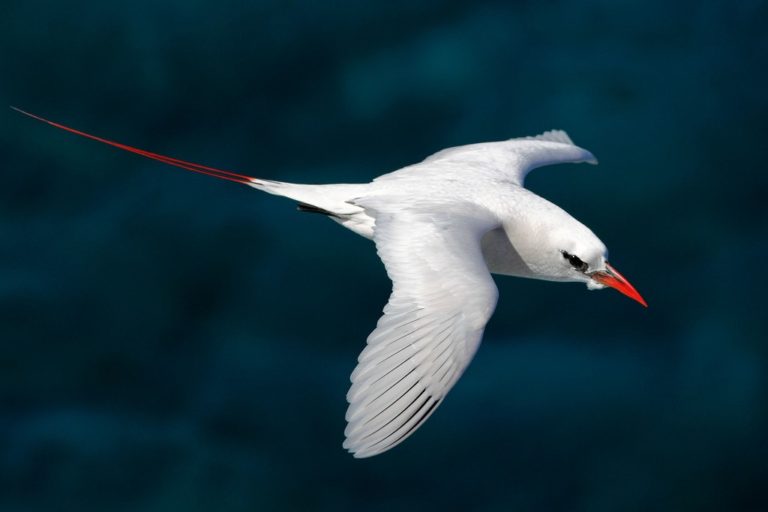
Red-tailed Tropicbird. (Maré, New Caledonia; September 19, 2009.) © juju98

Red-tailed Tropicbird. (Sand Island, Midway Atoll National Wildlife Refuge, Hawaii; April 30, 2019.) © Eric VanderWerf

Red-tailed Tropicbird. (Christmas Island; August 14, 2015.) © Ian K. Barker

Red-tailed Tropicbird. (Offshore from Kauai, Hawaii; March 20, 2019.) © Isaac Sanchez
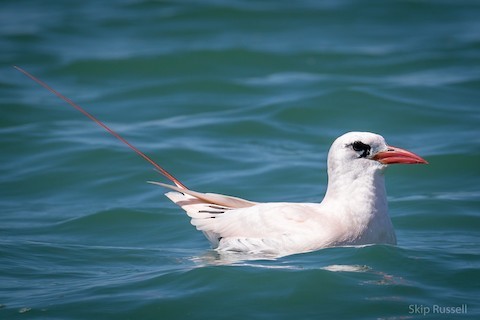
Red-tailed Tropicbird. (Nosy Ve, Madagascar; October 17, 2018.) © Skip Russell
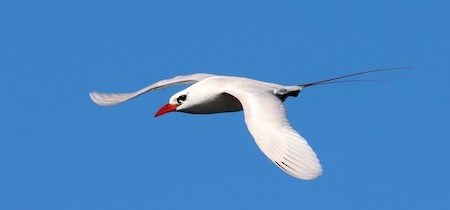
Red-tailed Tropicbird, showing vivid coral-red bill typical of early breeding season. (Kilauea Point National Wildlife Refuge, Kauai, Hawaii; March 4, 2020.) © Stefan Mutchnick

Red-tailed Tropicbird. (Norfolk Island, Australia; January 30, 2017.) © robbi_and_elisa
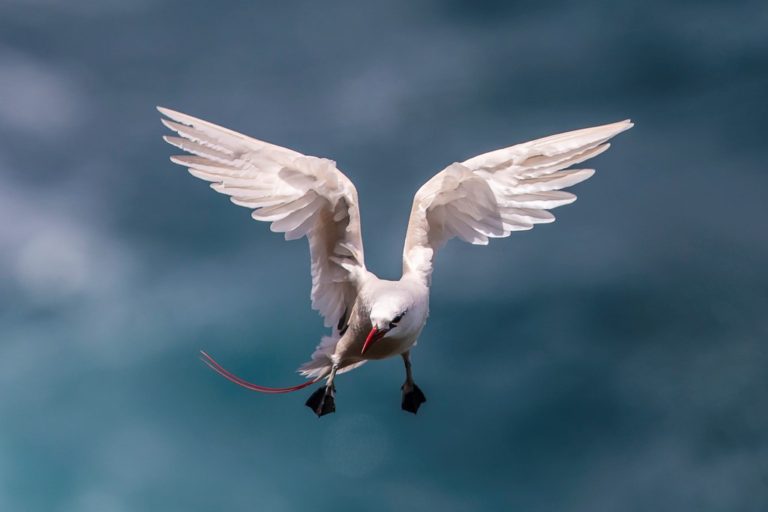
Red-tailed Tropicbird. (Kilauea Point National Wildlife Refuge, Kauai, Hawaii; June 29, 2018.) © Lee Hoy
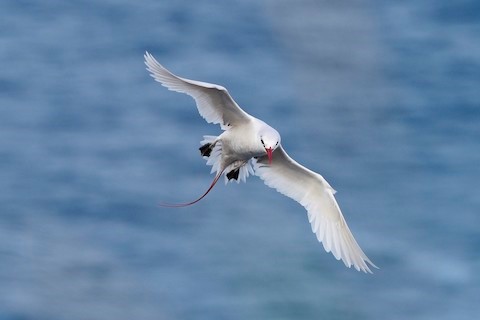
Red-tailed Tropicbird. (Kilauea Point National Wildlife Refuge, Kauai, Hawaii; February 27, 2020.) © Donna Pomeroy

Red-tailed Tropicbird. (Nosy Ve, Madagascar; November 12, 2016.) © Charley Hesse TROPICAL BIRDING
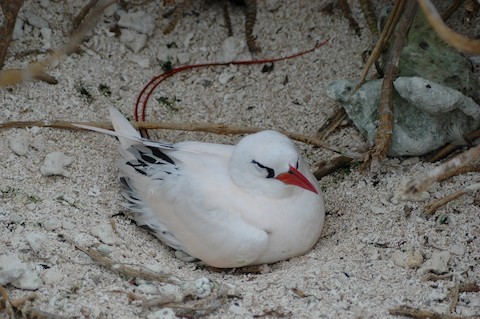
Red-tailed Tropicbird, on nest, showing black stripes on inner secondaries—note red streamers curved at rest on the sand. (Eastern Island, Midway Atoll National Wildlife Refuge, Hawaii; March 14, 2009.) © Steve Tucker

Red-tailed Tropicbird, close study of black teardrop marking, slight eyeline, and vivid coral-red bill. (Nosy Ve, Madagascar; August 2, 2019.) © Luis Mario Arce

Red-tailed Tropicbird, on nest, showing black stripes on inner secondaries. (Lady Elliot Island, Queensland, Australia; September 12, 2013.) © Andy Pearce
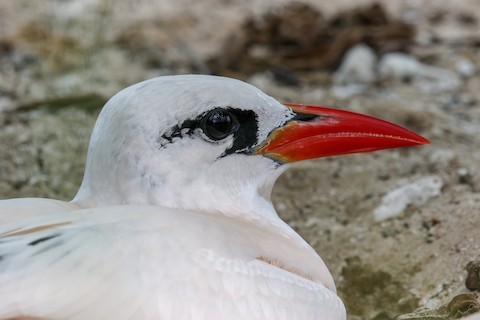
Red-tailed Tropicbird, close study of black teardrop marking, slight eyeline, and vivid coral-red bill. (Motu Tapu, Kiribati; February 22, 2019.) © George Henry Stirrett
Immature Plumages. Juvenile is similar overall to those of other tropicbirds: white and heavily barred and scalloped with black from the crown back to the rump and across the wing covets.
Immatures initially differ from other species mainly in having only thin black stripes and spots in the primaries. As they age, they quickly become white overall with just a few black bars and spots.
The juvenile’s bill is black, sometimes partly gray. Immatures’ bills are mixed pale-yellow and black, then progressively become more orange.

Red-tailed Tropicbird, immature showing mostly white wings. (Ogasawara Islands, Japan; July 6, 2018.) © Yann Muzika
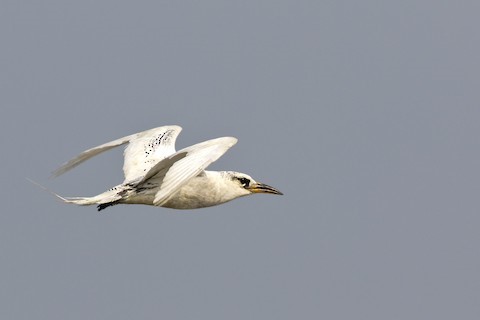
Red-tailed Tropicbird, immature showing mostly white wings and yellow-and-black bill. (Jambu Dweep, West Bengal, India; May 12, 2019.) © Arka Sarkar
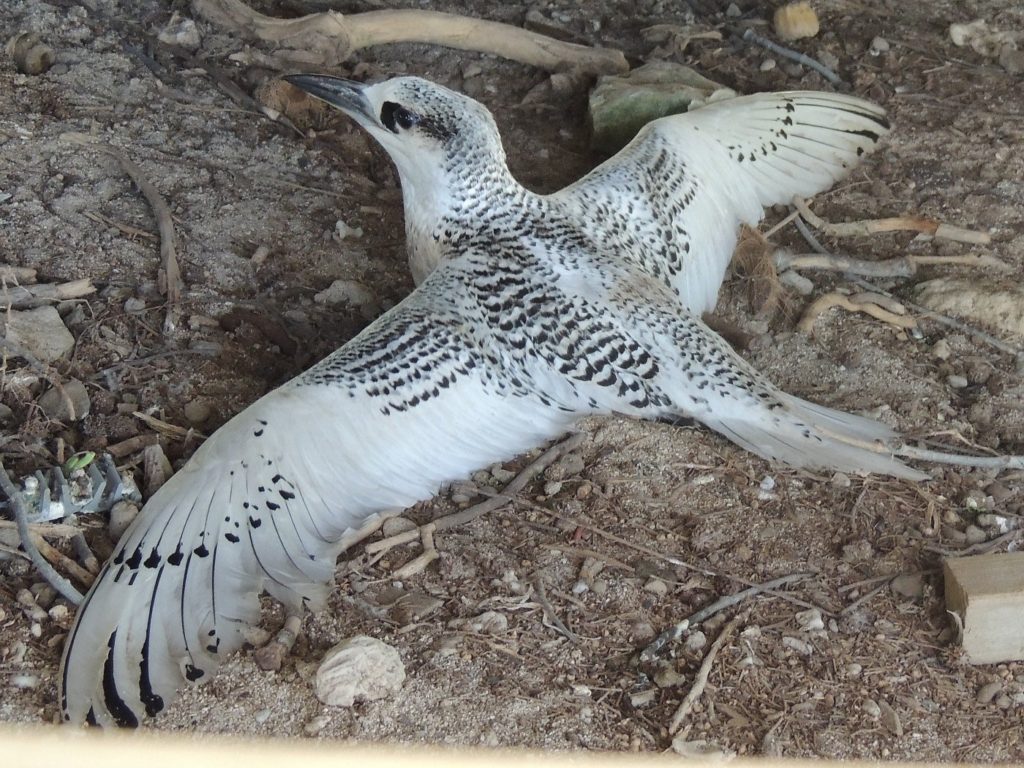
Red-tailed Tropicbird, juvenile showing pattern of black barring from crown and wing coverts to rump, and limited black spots and stripes on the primaries. (Lady Elliot Island, Queensland, Australia; January 2016.) © M. Mearns

Red-tailed Tropicbird, juvenile. (Lady Elliot Island, Queensland, Australia; November 23, 2008.) © Steve Murray
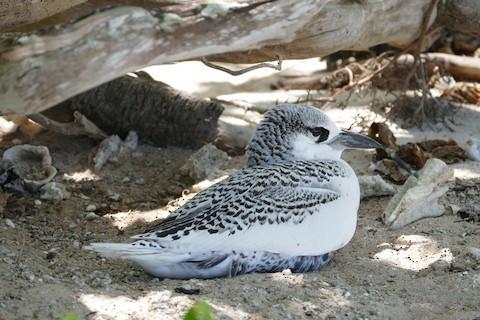
Red-tailed Tropicbird, fledgling. (Arutanga, Aitutaki, Cook Islands; August 25, 2017.) © Franky O’Connor
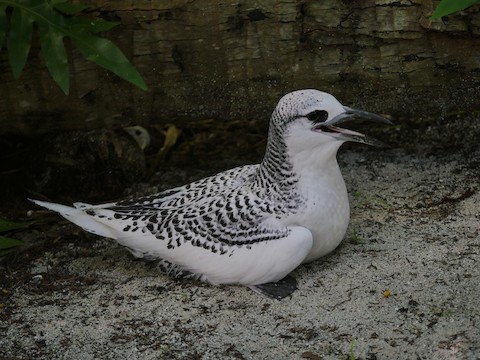
Red-tailed Tropicbird, juvenile. (One Foot Island, Cook Islands; July 25, 2016.) © Peter Lowe

Red-tailed Tropicbird, fledgling. (Lehua Islet, Hawaii; August 6, 2012.) © Oscar Johnson
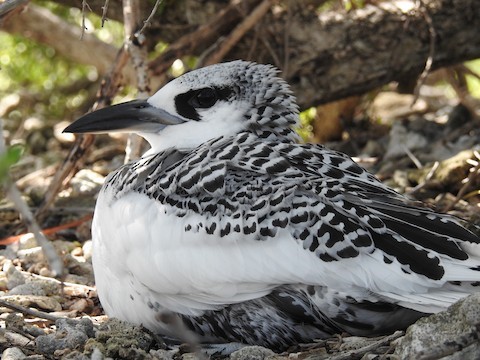
Red-tailed Tropicbird, juvenile. (Tongareva Atoll, Cook Islands; April 16, 2018.) © Dr. Michael White
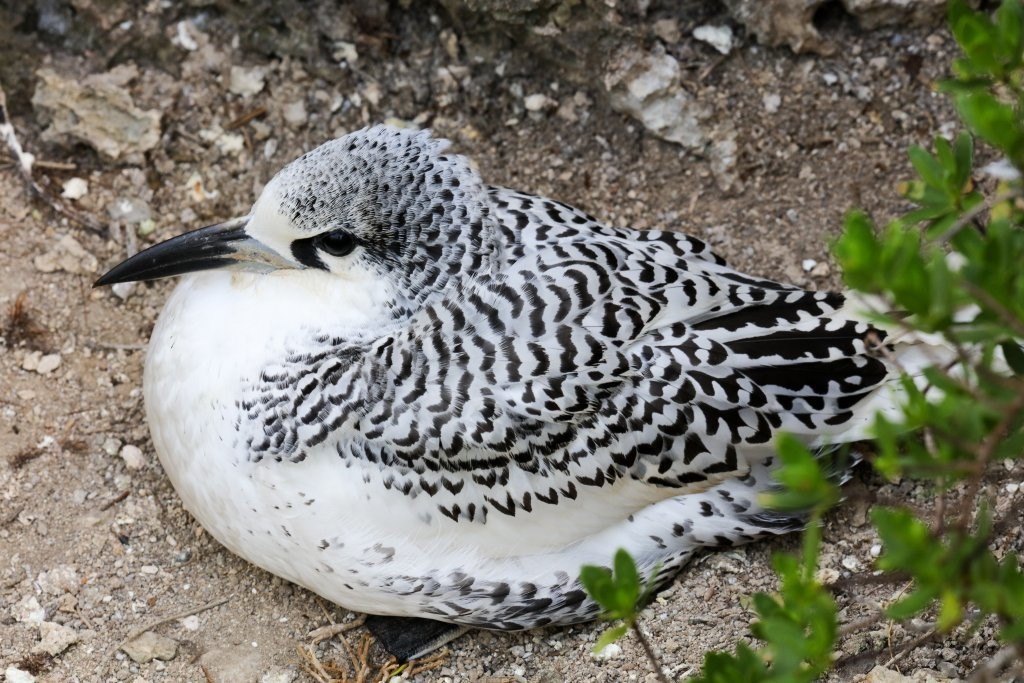
Red-tailed Tropicbird, fledgling. (Christmas Island; August 31, 2017.) © Hickson Fergusson
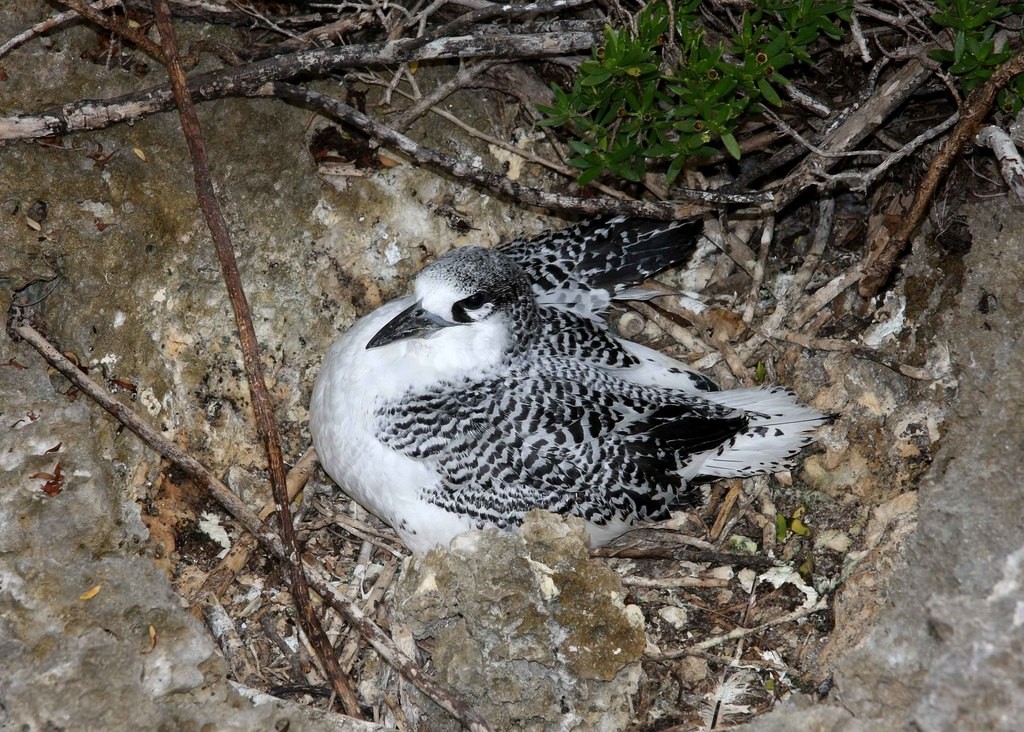
Red-tailed Tropicbird, fledgling. (Christmas Island; August 13, 2008.) © Linda Rogan
Cf. Immature Yellow-billed Tropicbird. Yellow-billed and Red-tailed Tropicbirds nest on many of the same islands throughout the tropical Indian and Pacific Oceans. Juveniles of the two species are extremely similar. At rest, they may be effectively indistinguishable, except for bill color: juvenile Red-tailed’s is mostly black with a paler gray base, whereas juvenile Yellow-billed’s is mostly pale—pinkish or horn-colored—often darker toward the tip. In flight, the most reliable difference is the amount of black in Yellow-billed’s outer primaries.
Notes
Polytypic species consisting of four recognized subspecies.
References
BirdLife International. 2018. Phaethon rubricauda. The IUCN Red List of Threatened Species 2018: e.T22696641A132586227. https://dx.doi.org/10.2305/IUCN.UK.2018-2.RLTS.T22696641A132586227.en. (Accessed August 17, 2020.)
Brazil, M. 2009. Birds of East Asia. Princeton University Press.
eBird. 2020. eBird: An online database of bird distribution and abundance. Cornell Lab of Ornithology, Ithaca, N.Y. http://www.ebird.org. (Accessed August 17, 2020.)
Harrison, P. 1983. Seabirds: An Identification Guide. Houghton Mifflin, Boston.
Howell, S.N.G., and S. Webb. 1995. A Guide to the Birds of Mexico and Northern Central America. Oxford University Press.
Howell, S.N.G., and K. Zufelt. 2019. Oceanic Birds of the World. Princeton University Press.
Pratt, H.D., P.L. Bruner, and D.G. Berrett. 1987. A Field Guide to the Birds of Hawaii and the Tropical Pacific. Princeton University Press.
Pyle, R.L., and P. Pyle. 2017. The Birds of the Hawaiian Islands: Occurrence, History, Distribution, and Status. Version 2 (January 1, 2017). http://hbs.bishopmuseum.org/birds/rlp-monograph/. B.P. Bishop Museum, Honolulu, Hawaii.
